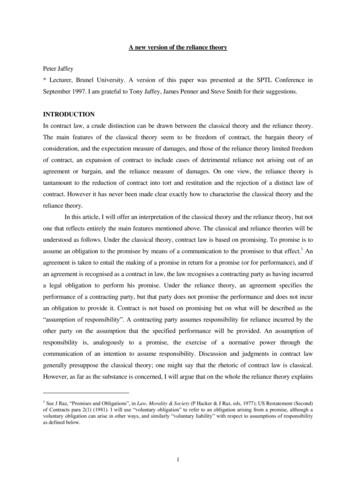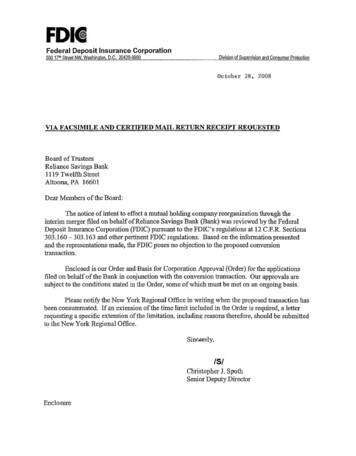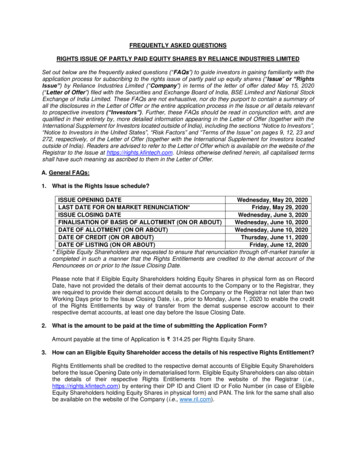
Transcription
A new version of the reliance theoryPeter Jaffey* Lecturer, Brunel University. A version of this paper was presented at the SPTL Conference inSeptember 1997. I am grateful to Tony Jaffey, James Penner and Steve Smith for their suggestions.INTRODUCTIONIn contract law, a crude distinction can be drawn between the classical theory and the reliance theory.The main features of the classical theory seem to be freedom of contract, the bargain theory ofconsideration, and the expectation measure of damages, and those of the reliance theory limited freedomof contract, an expansion of contract to include cases of detrimental reliance not arising out of anagreement or bargain, and the reliance measure of damages. On one view, the reliance theory istantamount to the reduction of contract into tort and restitution and the rejection of a distinct law ofcontract. However it has never been made clear exactly how to characterise the classical theory and thereliance theory.In this article, I will offer an interpretation of the classical theory and the reliance theory, but notone that reflects entirely the main features mentioned above. The classical and reliance theories will beunderstood as follows. Under the classical theory, contract law is based on promising. To promise is toassume an obligation to the promisee by means of a communication to the promisee to that effect.1 Anagreement is taken to entail the making of a promise in return for a promise (or for performance), and ifan agreement is recognised as a contract in law, the law recognises a contracting party as having incurreda legal obligation to perform his promise. Under the reliance theory, an agreement specifies theperformance of a contracting party, but that party does not promise the performance and does not incuran obligation to provide it. Contract is not based on promising but on what will be described as the“assumption of responsibility”. A contracting party assumes responsibility for reliance incurred by theother party on the assumption that the specified performance will be provided. An assumption ofresponsibility is, analogously to a promise, the exercise of a normative power through thecommunication of an intention to assume responsibility. Discussion and judgments in contract lawgenerally presuppose the classical theory; one might say that the rhetoric of contract law is classical.However, as far as the substance is concerned, I will argue that on the whole the reliance theory explains1See J Raz, “Promises and Obligations”, in Law, Morality & Society (P Hacker & J Raz, eds, 1977); US Restatement (Second)of Contracts para 2(1) (1981). I will use “voluntary obligation” to refer to an obligation arising from a promise, although avoluntary obligation can arise in other ways, and similarly “voluntary liability” with respect to assumptions of responsibilityas defined below.1
the law of contract more convincingly than the classical theory, and provides solutions to importantproblems in the law of contract. I will also distinguish this version of the reliance theory from otherversions, including the “death of contract” thesis, and show how it is not open to the criticisms made ofthem.2After an explanation of the rationale of this version of the reliance theory, I will discuss theclassical and reliance theories in relation to various aspects of contract law, including the overlap withtort and restitution. In a brief final section I will consider one or two more fundamental issues concerningthe reliance theory that are touched upon elsewhere in the article.The reliance theory and the “assumption of responsibility”People have an interest in exchanging benefits, and in particular exchanging a benefit for payment.Typically one party (the “recipient”) will receive a benefit in the form of a good or service and the other(the “supplier”) will receive a benefit in the form of payment to compensate him for his expenses andremunerate him for his work (or provide a return on his investment). Generally such exchanges will nottake effect without a prior (or simultaneous) agreement; in the absence of an agreement it will notgenerally be fair to expect the recipient to pay for anything he has received, nor practicable to assess theappropriate payment.3 Such an agreement should be legally enforceable, so that the parties can feelsecure in proceeding with performance where, as is usually the case, this involves some work orexpenditure or opportunity cost before anything is received in return. It is the role of contract law to giveeffect to agreements. The classical theory of contract presumes that the agreement consists of anexchange of promises - generally a promise to provide a benefit and a promise to pay for it - whichgenerate obligations in law to provide the benefit and to pay for it. But the exchange of benefits canequally take effect under an agreement consisting of assumptions of responsibility rather than theexchange of promises.In an agreement as interpreted under the “assumption of responsibility” version of the reliancetheory, the parties do not say, as the classical theory envisages, “I promise to do this, and you promiseto do that”, but “We will proceed on the assumption that I am to do this and you are to do that, and,although I do not promise that I will do this, I accept responsibility for your reliance on the assumptionthat I will, and you will accept responsibility for my reliance in the same way.” The effect of an2The reliance theory is associated with, amongst others, LL Fuller & WS Perdue, “The reliance interest in contract damages”(1936) 46 Yale LJ 52; PS Atiyah, Essays on Contract (1986), Promises, Morals, and Law (Oxford, 1981), The Rise and Fallof Freedom of Contract (Oxford, 1979); G Gilmore, The Death of Contract (Ohio State University Press 1974); J Raz,“Promises in morality and law” (1982) 95 Harv LR 916; H Collins, The Law of Contract (Butterworths, 3rd ed 1997).3Falcke v Scottish Imperial Insurance (1886) 34 Ch D 234 is taken to be authority for the general rule that no liability arisesfor an uncontracted-for benefit.2
assumption of responsibility is to subject the contracting party to a contingent liability to satisfy thereliance interest (in the sense defined below), but not a duty to carry out the performance specified inthe contract.4 In this way each party will proceed with the exchange of benefits as envisaged, with thereassurance not that the performance he expects is his legal entitlement by virtue of an obligation owedto him, but that at least he will not lose out as a result of embarking on the exchange. This type ofarrangement may not provide as much security as an agreement that generates an entitlement to thecontracted-for benefit, because there will inevitably be problems of measurement of the consequencesof reliance. But it has the advantage that it is less burdensome in constraining the parties' behaviour andleaves them the option of abandoning performance subject to a liability to satisfy the other's relianceinterest. It is plausible that a party who is to provide goods or services for payment is likely to prefer anarrangement that does not bind him to perform but leaves him the option to do something else subjectonly to a liability to satisfy the reliance interest.5 A party who is to receive work or goods might ideallyprefer the security of an obligation of performance, but it is plausible that he will accept an arrangementthat protects his reliance on the contract if this is what the other party prefers and under it he will offera lower price.6REMEDIESDamagesThe classical theoryThe appropriate measure of damages to protect the interest of a promisee under the classical theory isclear in principle. As Professor Friedmann has recently explained, the expectation measure of damagesclearly follows from the very recognition of a contractual obligation.7 If the law recognises that by4It is better to refer to a contingent liability rather than a contingent obligation, because an obligation denotes what ought to bedone and a liability (in this context) represents a sum owing and can be distinguished from the obligation to pay it.5Even if this means that he will receive only payment for what he does, and does not have any prospect of obtaining his netprofit on the contract without having to do the work (as may happen under the classical theory).6The theory of economic breach also postulates the absence of a duty of performance, although it is perversely expressed interms of a right or freedom to breach a duty of performance. For a critique based on this contradiction see D Friedmann, “TheEfficient Breach Fallacy” (1989) 18 Journal of Legal Studies 1. The theory of efficient breach purports to explain the freedomof a contracting party not to perform in terms of wealth maximisation: eg Posner, Economic Analysis of Law (Little, Brown,4th ed 1992), 117-119. By contrast, the argument here is that the freedom not to perform follows from what the parties haveagreed. They reach this agreement because they judge that this best serves their interests, and consequently (since generallyonly their interests are at stake) it will also generally be wealth-maximising. But the justification for recognising a freedom notto perform is simply the agreement, not that it is wealth-maximising. Thus efficiency arguments have no justificatoryrelevance, although they may be of assistance in judging what the parties have agreed, or, with respect to implied terms, whatthey would have agreed.7Daniel Friedmann, “The Performance Interest in Contract Damages” [1995] LQR 628; Charles Fried, Contract as Promise(1981, Harvard University Press) 17-21; see also Ernest J Weinrib “The Juridical Classification of Obligations” in P Birks, ed,The Classification of Obligations (OUP, 1997).3
virtue of a legally binding contract the promisor has incurred an obligation to provide a specifiedperformance to the promisee, the promisee must be entitled to the value of the performance, less thesaving of the cost of his own performance - which means the expectation measure - if he does notreceive the performance itself. This can be described as the simulation principle, i.e., the principle thatthe function of the remedy is to simulate the performance by conferring its equivalent in pecuniarydamages. This corresponds of course to the normal remedy for breach of contract recognised by thecourts.8The contractual expectation measure is usually contrasted with the tortious measure, but, asFriedmann points out, there is really no difference in principle between the assessment of damages incontract and tort.9 Both apply the simulation principle, and the difference lies in the nature of theobligation. In tort law, damages simulate compliance by the defendant with the obligation that hebreached to avoid harm to the plaintiff by compelling him to pay an amount representing the cost of theharm to the plaintiff, whereas in contract they simulate the breach of an obligation to confer a benefitby requiring payment of the value of the benefit.10The measure of damages under the reliance theoryThe appropriate measure of damages under the reliance theory - the amount necessary to satisfy thereliance interest - is not as straightforward in principle. This is so because generally it is the sumnecessary to put the plaintiff in the position he would have been in if he had not entered the contract,and this may be a matter of conjecture. It can relate to opportunity cost or work done or sumsexpended.11 It is usually regarded as a major obstacle to the reliance theory that it is the expectationmeasure that is the normal measure of damages in contract law. However it is reasonably clear, first,that the appropriate measure of damages to satisfy the reliance interest should not exceed theexpectation measure.12 A party will not embark on a contract unless he considers at the time of thecontract that the value to him of the contract will at least equal whatever other benefit he may otherwise8British Westinghouse Electric v Underground Electric Railways [1912] AC 739Friedmann, op cit at n 7, 638-43. See also JE Penner, “Voluntary Obligations and the Scope of the Law of Contract” (1996) 2Legal Theory 325.10It has sometimes been suggested that tort law does protect expectations, for example in the form of lost earnings or damageto prospects: see e.g. K Barker “Are we up to expectations? Solicitors, beneficiaries and the tort/contract divide” (1994) 14OJLS 137, 146-7. This is true, but betrays a misunderstanding of “expectation loss” in contract, which is used (maybe inaptly)to mean a loss in the form of a shortfall in a benefit due from the defendant to the plaintiff. See also J. Stapledon, “The NormalExpectancies Measure in Tort Damages” (1997) 113 LQR 257, 259.11Anglia TV v Reed [1972] 1 QB 60 is an example of a claim for expenditure.12Consistently with C & P Haulage v Middleton [1983] 1 WLR 1461 and CCC Films (London) Ltd v Impact Quadrant Films[1985] QB 16.4
obtain (his opportunity cost).13 This means that putting the plaintiff in the position he would have beenin if the contract had been performed will necessarily ensure the satisfaction of his reliance interest, asvalued by him at the time of the agreement. At the same time, from the defendant‟s point of view,limiting the claim to the expectation measure means that the defendant‟s liability cannot exceed thecost to the defendant of his own specified performance. Of course the agreement, and the implicitvaluation of the plaintiff‟s reliance interest with the expectation measure, is made before the partiesknow for sure how much expenditure or expertise or effort is necessary, or what the opportunity costmay turn out to have been, and so the plaintiff‟s loss may in fact turn out to exceed the expectationmeasure. Nevertheless limiting the claim to the expectation measure is appropriate because its effect isto allocate risk with respect to factors affecting the cost and value of performance that are unknown ordifficult to judge at the time of contracting or change subsequently.14 The supplier takes the risk ofchanges in the cost of providing the benefit sought by the recipient or the value to him of the necessarywork, and the recipient takes the risk that, as things turned out, he might have spent his time and moneyin a way that was more valuable to him. Holding the parties to the valuation gives effect to theagreement and is generally fair because it was the basis on which the parties incurred reliance orassumed responsibility for it.15It is maybe more difficult to show that the expectation measure is not excessive as a means ofsatisfying the reliance interest. Whenever a party embarks on a contract, he might have chosen to dosomething else, and this other option (whose value to him is the opportunity cost of the contract) mighthave been only marginally less valuable to him than the contract he made - in other words, it may bethat the plaintiff would not have entered the contract if the benefit offered by the defendant had beenany less than it actually was. In the case of a competitive market, this will generally be the case. In sucha case the expectation measure is apt as a measure of what is necessary to satisfy the reliance interest.But even in other cases, where there was no other equivalent benefit available, it may nevertheless bethe case that the plaintiff‟s opportunity cost approximated to the value of the contract to him, by virtueof a quite different alternative benefit, but here it will be extremely difficult for the plaintiff to establish13Or, as considered below, in the case of a supplier, the sum of his own costs and the minimum he is prepared to be paid inaddition for his work if this exceeds the opportunity cost.14See Fuller & Purdue, op cit at n2, at 79. In the same way the exchange of promises allocates risk under the classical theory.15Aside from issues of exploitation or mistake or a jurisdiction to upset grossly unfair contracts. Limiting the plaintiff to theexpectation measure by virtue of the contractual valuation is quite different from saying that the plaintiff is limited to hisreasonable reliance loss, and that loss incurred in reliance on the assumption that the defendant will provide a specifiedperformance cannot be reasonable if it exceeds the value of the performance. It is quite possible that the plaintiff might actreasonably in reliance and then discover that his expenditure in reliance, or his opportunity cost from performing this contractrather than another one, exceeds the value of the benefit he was due to receive from the defendant. The contractual valuationin this sense is also quite different from saying that the benefits obtained by the two parties under the contract are equal, whichis implausible.5
the fact.16 Given that the defendant assumed responsibility for the plaintiff‟s reliance loss, he should notbe able to take advantage of this difficulty, and so arguably the expectation measure should be awardedbecause it gives the plaintiff the benefit of the doubt and relieves him of the need to prove his actualreliance loss.17Furthermore, the plaintiff may well have incurred just as much reliance loss when the contractbreaks down early as when it breaks down towards completion. As soon as he has begun to rely on thecontract, he may already have given up an alternative contract. Thus, even if the contract breaks downearly on, the plaintiff needs to receive the expectation measure if the difficulty of proving reliance lossis resolved in his favour. Although in principle the contract should not be of any effect until there hasbeen actual reliance, because of the difficulty of determining whether reliance (for example anopportunity cost) has yet occurred, it is reasonable that a court should assume that there has beenreliance once the contract has been made. In reality it may sometimes be clear to the parties, if not tothe court, particularly in the case of early termination, that the expectation measure is liable to beexcessive as a measure of reliance loss.18 There is some empirical evidence that business people regardthe availability of the full expectation measure in all cases as excessive, and that, at least in the contextof a continuing relationship, they do not usually demand it.19 This is understandable in the light of thereliance theory, even if the expectation measure remains appropriate where the matter reaches court inorder to protect the plaintiff from the difficulty of proof, but it is difficult to understand in the light ofthe classical theory‟s interpretation of an agreement.Where the contract has ended early, the plaintiff may be able to take up alternative contracts orother activities that would have been precluded if the contract had continued to completion. Theseconstitute part of the opportunity cost that make up the reliance interest in respect of his wholecontractual performance, and because they are now available to him, their value cannot be included in16Thus the opportunity cost argument need not be confined to the case of a competitive market or the “credit system” assuggested by Fuller & Purdue, op cit at n2, 64.17Friedmann argues (op cit at n7, 638) that the plaintiff cannot claim that the benefit he would have obtained from anothercontract is his opportunity cost because if he is confined to the reliance measure he would not have been entitled to the fullbenefit from that contract (and similarly with respect to further hypothetical contracts). But so long as contracts are generallyperformed rather than broken, the opportunity cost of a missed contract approximates to the full benefit that would have beenobtained through it, even if recovery is in the reliance measure.18As in Centrovincial Estates v Merchant Investors (1983) Com LR 158. The fact that under the expectation measure theplaintiff receives the net profit for the whole contract and not just for the part of it he has done has been criticised by PSAtiyah “Contract, Promises & Obligations” in Essays on Contract, (Oxford, 1996), 32ff; and see also Melvin Aron Eisenberg“The Bargain Principle and its Limits” (1992) Harv LR 785-98.19See S Macaulay, “Non-Contractual Relations in Business: A Preliminary Study” (1963) 28 Am Soc Rev 55, 61; H Beale &A Dugdale (1975) 2 Brit J L&S 45, 53. Macaulay seems to have inferred, from the disparity between the results in thesestudies and the prescriptions of the classical theory, that the law is largely or often inconsistent with the parties‟ understandingof their agreement. This sceptical response is unnecessary under the reliance theory.6
his reliance claim, which diminishes accordingly. A plaintiff-recipient may still be able to make acontract to procure exactly the same benefit, so that his reliance loss is nil; similarly a plaintiff-suppliermay be able to take up alternative work which will reduce his claim in the expectation measure by theamount he can earn through the work he can now do instead of the contractual performance. This is theeffect of the rule of mitigation, which, as considered below, is in certain respects difficult to reconcilewith the classical theory.There may be cases where it is not appropriate to resolve the doubt over the plaintiff‟s relianceloss in his favour, so that his claim should be limited to actually provable reliance loss. This might bethe case where, rather than the defendant having failed to perform in accordance with the contract, thecontract has been frustrated. Here either party might have a prima facie claim for his reliance loss, butarguably it would be appropriate to expect the parties to prove actual reliance loss. Similarly it has beenargued that in some circumstances a party who has himself failed to perform should have a claim ifotherwise the other party would be left better off than if the contract had been performed. Here againthe plaintiff should have a reliance claim, but only for provable reliance loss and not in the presumptiveexpectation measure.20Where the plaintiff has to prove the actual reliance measure, he should be able to claim inrespect of work actually done as well as actual expenditure or a proved opportunity cost, even if thework done entailed no provable opportunity cost. Doing work does not in itself entail a loss, although itmay entail an opportunity cost; but the satisfaction of the reliance interest should require payment forlabour as such, because it is part of the purpose of contract to protect the interest in being paid forlabour done in reliance on a contract, irrespective of whether the labour entailed any loss.21 Where theplaintiff is permitted the expectation measure as a measure of his opportunity cost, the interest inpayment is implicitly protected, because the opportunity cost includes payment for labour that wouldhave been received through another contract. The lesser claim for actual reliance loss will, in the caseof a supplier of work and materials, be for a fraction of the price of the work corresponding to thefraction of the total work required for complete performance. This reflects the contractual valuation ofthe plaintiff‟s reliance loss in terms of the value to him of the defendant‟s reciprocal performance. Thisfalls short of the expectation measure (which is the price less the expenditure saved) by the net profit onthe work not done. This lesser claim is not unknown to the law: it is the quantum meruit claim for work20See under “Restitutionary claims in contract” below.21One might argue that the opportunity cost is necessarily the minimum amount the plaintiff would have accepted for thework. But where the plaintiff has done work pursuant an agreement to pay his reliance interest requires payment for the workirrespective of whether he has incurred a loss.7
and materials, typified by the old case of Planché v Colburn.22 The quantum meruit claim is usuallyregarded as a non-contractual restitutionary claim,23 but this account reveals it clearly as a contractualreliance claim.24 The quantum meruit (in this sense) seems to be awarded only exceptionally, where theplaintiff does not get the benefit of the doubt over the measure of his reliance loss.25 However thequantum meruit will tend to correspond to the award that the plaintiff is left with where under themitigation rule his claim is reduced to exclude the net profit he did or could have made from anothercontract.The reliance and restoration measures, and the non-contractual quantum meruitIt is helpful to contrast the reliance measure with what may be called the “restoration measure”.26 Therestoration measure represents the plaintiff's loss from entering the contract, measured independently ofthe contract (i.e., not in terms of the value of the performance due to him), and excluding any measure ofpayment for work done. The restoration measure would be the appropriate measure of recovery if thedefendant had committed a tort in the making of the contract, for example a misrepresentation, but itcannot be appropriate as a remedy arising from the contract itself because it is inconsistent with thecontractual valuation and may exceed the expectation measure.27Also the contractual quantum meruit or reliance claim in respect of work done and expenditurevalued in accordance with an agreement should be distinguished from the non-contractual quantummeruit in respect of loss incurred and payment for work done in conferring a benefit measuredindependently of any contract or in the absence of a contract. The non-contractual quantum meruit is alsoinappropriate as a remedy arising out of a valid contract, because it is inconsistent with the contractualvaluation. It may for example exceed the expectation measure where a contract turns out to have been a22(1831) Bing 14.23The historical reasons why the quantum meruit is treated as non-contractual are complex. See for example Pavey & Matthewsv Paul (1986) 162 CLR 221; D Ibbetson “History in the High Court of Australia” (1988) 8 OJLS 312. In the modern law themischaracterisation results from the assumption induced by the classical theory that a breach of contract can generate only anexpectation claim representing the cost of the defendant's breach to the plaintiff on the assumption that the plaintiff had anentitlement to performance.24The quantum meruit can also refer to the price for work done awarded where the plaintiff was employed on the basis that hewould be paid for what he did rather than by way of a price for a specified performance, where it is consistent with both theclassical and the reliance theories.25There is no reason why the plaintiff should prefer the quantum meruit, since, like the reliance claim generally, it must besubject to the “contractual ceiling”: this limitation is generally recognised by those who regard it as a non-contractualrestitutionary claim: see Goff & Jones, The Law of Restitution (Sweet & Maxwell, 4th ed, 1993), 427.26For a discussion that is not based on a reliance theory but uses some similar concepts to those used here, see Eric GAnderson, “The Restoration Interest and Damages for Breach of Contract” (1994) 53 Maryland LR 1.27The restoration measure could include the expenditure incurred, opportunity cost, prepayment, and the cost of undoing work:this appears to be the measure recognised by the courts for misrepresentation.8
poor bargain for the plaintiff, because the contract price is insufficient to cover his expenditure and payhim a reasonable rate for his work. In the exceptional case of necessitous intervention it may beappropriate for the plaintiff to be entitled to a non-contractual quantum meruit in respect of a benefitconferred in the absence of a prior agreement to pay for it.28Restitutionary claims in contractThere are two claims that arise on the termination of contract that are traditionally regarded asrestitutionary rather than contractual. The first is the claim for a quantum meruit in respect of work doneunder a contract. This is incongruous in the classical theory, for which the simulation principle requiresthe expectation measure. But as suggested above, if the claim is allowed it is explicable as a relianceclaim; there is no need to resort to a restitutionary or other non-contractual account.29 The explanationunder the reliance theory can also account for a claim by a party who himself failed to perform, or byeither party on the frustration of the contract.30 Such a claim is difficult to explain as a contractual claimunder the classical theory because it clearly does not arise from any breach of duty, and the fact that it isor ought to be available to a party in breach or to either party on frustration has been invoked in supportof the argument that it must be restitutionary and not contractual.31 But under the reliance theory a claimdoes not arise from a breach of duty, but from an assumption of responsibility for the reliance interest.On frustration, it is reasonable that the parties should incur such liabilities as are necessary to ensure thatreliance loss is shared fairly between them.32 And even when it was the plaintiff who decided not toperform or failed to perform, it may be appropriate for the defendant, even though he was always willingand able to perform, to satisfy some part of the plaintiff's reliance interest if otherwise the defendantwould end up with a surplus beyond what is necessary to satisfy his own reliance loss.33The second is the claim to recover a prepayment in the event of complete failure ofconsideration. Where the plaintiff has made a prepayment to the defendant, he is entitled to recover theamount of the payment instead of damages in the expectation measure, even if the amount of the28See P Jaffey, “The Restitutionary Conditional Transfer Theory and the Death of Contract” [1998] Edinburgh LR(forthcoming). For an efficiency argument, see Andrew Kull, “Restitution as a Remedy for Breach of Contract” (1994) 67 SCalif LR 1465,1472.29For suc
classical and reliance theories in relation to various aspects of contract law, including the overlap with tort and restitution. In a brief final section I will consider one or two more fundamental issues concerning the reliance theory that are touched upon elsewhere in the article. The reliance theory and the "assumption of responsibility"










